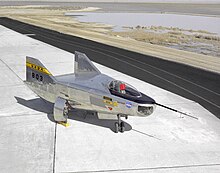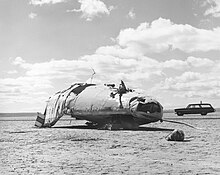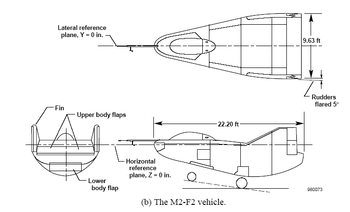Northrop M2-F2
The Northrop M2-F2 was an American experimental aircraft based on the lifting body concept . It was the second in a line of experimental wingless aircraft tested between 1963 and 1975. Other machines were:
- the NASA M2-F1 (1963)
- the Northrop HL-10 (1966)
- the Martin-Marietta X-24 (1969)
The designation "M2-F2" stood for Manned, 2nd modification - Fuselage 2 (second body shape). With these machines it could be shown that wing and non-propulsion aircraft can be safely controlled and landed at a defined point.
Flight attempts
After the successful test of the M2-F1, NASA commissioned Northrop with the construction of two more lifting bodies (the HL-10 and the M2-F2), which should now be made of metal and thus weighed many times their predecessor. The M2-F2 was completed in early 1966, took off for the first time on March 23 (attached to a B-52) and made its maiden flight on July 12, 1966 with Milt Thompson at the controls, switching from a Boeing B-52 to a Height of 12,500 meters was brought and notched.
crash
The M2-F2 proved to be difficult to steer and tended to rock; on August 16, 1966, on the 16th flight with pilot Bruce Peterson at the wheel, there was a serious accident. He only managed to intercept the machine shortly before the ground, whereby the landing gear no longer extended properly, the machine rolled over several times and Peterson was seriously injured. The footage of the accident was used as the opening credits for the film The Six Million Dollar Man .
Resumption of flight attempts
The machine was repaired after the accident. She was provided with a third, centrally mounted vertical stabilizer (which greatly improved the controllability), provided with a new outer skin and now referred to as the Northrop M2-F3 . The first flight took place on June 2, 1970 with Bill Dana at the wheel. The machine flew 26 more times to research the high-speed behavior of the construction, with it on December 13, 1972 again with Bill Dana on board Mach 1.6 and flown by John Manke on December 21, 1972 reached an altitude of over 21,500 meters.
Whereabouts
The machine is on display today as an exhibit in the entrance hall of the National Air and Space Museum in Washington, DC .
Technical specifications
- Crew: 1
- Length: 6.76 m
- Wingspan: 2.94 m
- Height: 2.89 m
- Wing area: 14.9 m²
- Empty weight: 2095 kg (M2-F2), 2300 kg (M2-F3)
- Takeoff weight: 2722 kg - 3600 kg
- Propulsion: 1 × XLR-11 rocket engine with four nozzles and 36 kN thrust
- Top speed: 750 km / h (M2-F2) - 1700 km / h (M2-F3)
- Range: 72 km (M2-F3)
- Greatest flight altitude reached: 21.793 m (M2-F3)
swell
- FliegerRevue 3/2008, pp. 58-61, "Lifting Bodies and Moon Landing Trainers"
- M2-F2 ( memento of July 16, 2012 in the Internet Archive ) nasa.gov
Web links
Individual evidence
- ↑ Fred Anderson: Northrop: An Aeronautical History , p. 229 ( Google Books excerpt )


